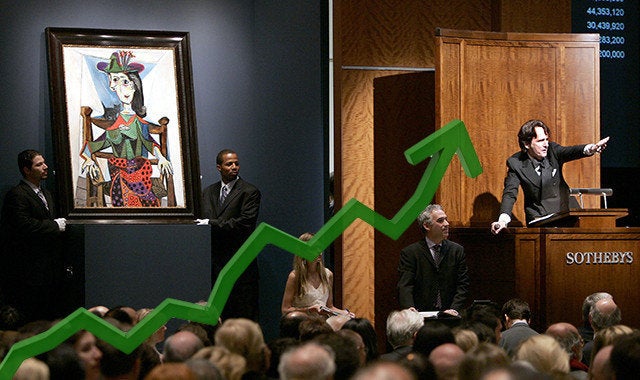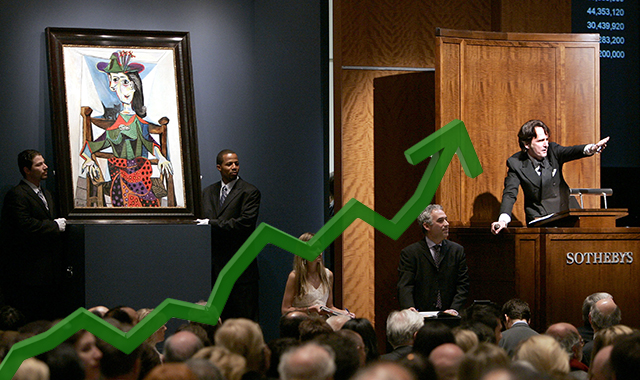
So you think you want to invest in art? Diversifying portfolios by purchasing tangible luxury assets has become increasingly fashionable over the last decade, and fine art is a popular way to do that -- financiers, celebrities, and royals are known the clog the salesrooms of the biggest auction houses during the elaborate evening sales in New York and London. But under the glittering lights, it's easy to forget that buying a Picasso as an investment is a great way to lose $20 million if you don't do it carefully.

Pablo Picasso's " Dora Maar au chat" is auctioned by Tobias Meyer at Sotheby's New York / Timothy A. Clary/AFP/Getty Images
Experts have plenty to say both for and against art investing, and we've tried to sum up both sides of the debate on four key issues: Risk, Regulation, Cost, and Taxes. (To see this story as an illustrated slideshow, click here.)
Point 1: It's Too Risky
There is no guarantee that your artwork is going to increase in value -- much art is doomed to go out of fashion. An individual work or series of works can even decline in value while other works by that artist appreciate. Art can be appraised, but it's not liquid enough to actually mark it to market. An appraised value is no guarantee of getting that price on the secondary market. In fact, just this week, writer, dealer, and collector Adam Lindemann wrote that he has noticed work is selling for much less on the secondary market than in the primary market -- the opposite of the way the market worked a decade ago: "very often, when you buy a brand new piece in a gallery, my view is that it's worth half the moment you walk out the door," he wrote. Not a great basis for investing, in other words.
Counterpoint 1:
But then again, some works will increase dramatically in value. All investments carry some sort of risk, and generally the higher it is the higher the reward. Art is high risk and not always high reward (there are high transactions costs and high carrying costs, even if it does appreciate). Thus, art is a luxury asset that shouldn't be considered in isolation: A single Damien Hirst painting shouldn't be your retirement plan. Still, it's not a bad diversification tool, particularly if you also happen to derive emotional value from hanging it on the wall. If you want to buy art with a small portion of your wealth as a way to enliven your living space while also purchasing a tangible asset, that's great -- just know when you walk out of the gallery that you risk being stuck with it forever.
Point 2: The Market is Opaque and Difficult to Navigate
There have been an assortment of recent articles discussing the unregulated nature of the art market, most prominently a front-page article in the New York Times last week. It's true that the odds are stacked against the new collector. Dealers operate in a murky shadow world, and money flows from information asymmetries. The ones who make a profit off the art market are those who know the industry front-to-back and have the deep pockets to buoy the markets of their artists when interest wanes.
Counterpoint 2:
It's unequivocally true that the art market is not user friendly. Making money off art requires having an extreme amount of either luck, knowledge, or capital (usually you need all three). If you are new to the market, trying to go it alone is particularly risky -- you are very likely to get ripped off. Being smart about investing in art requires a long time horizon. The art world might be confusing, but it's not rocket science. Buying art that you like from emerging and mid-career artists with the help of a knowledgeable advisor will likely pay off much better than putting up $45 million for a Picasso that no one else wanted (for a reason).
Point 3: It's Expensive to Hold
As an investment, art is illiquid and expensive to insure. Dividends are non-existent. If you are serious about keeping it as an asset, it will need to be re-appraised every few years. It's difficult and expensive to move. You have to make sure that your home has the right light and is kept at the right temperature. Simply put, having art on your walls is a money-suck.
Counterpoint 3:
This goes back to art being a passion investment. While it is very expensive to keep, you should also be getting some sort of non-monetary value from it -- something other forms of investment can't offer. If you don't actually like art, it probably isn't worth it. Alternatively, there are plenty of freeport storage spaces in Switzerland and Singapore to be had for the investment Picassos that don't speak to you.
Point 4: The Taxes Are Terrible
Capital gains on art and collectibles get taxed at a rate of 28 percent, rather than the 15 percent charged for normal capital gains. This is fine if you plan to donate your art collection to a museum, but problematic if you want to sell it or leave it to an heir. Despite art valuation seeming somewhat ambiguous, fudging the value of a collection downward is not terribly easy. The IRS has a special Art Advisory Panel that audits the artwork valuations reported to the government for tax purposes, and in almost half of their cases recommended making adjustments on the appraisal. This has, in the worst cases, resulted in multi-million-dollar disagreements between the government and heirs of collectors.
Counterpoint 4:
There is no real counterpoint here; the taxes on art are terrible. If you want to invest in art, you better also be investing in a good estate-planning attorney.
-Author, Shane Ferro BLOUIN ARTINFO
More of Today's News from BLOUIN ARTINFO:
Like what you see? Sign up for BLOUIN ARTINFO's daily newsletter to get the latest on the market, emerging artists, auctions, galleries, museums, and more.